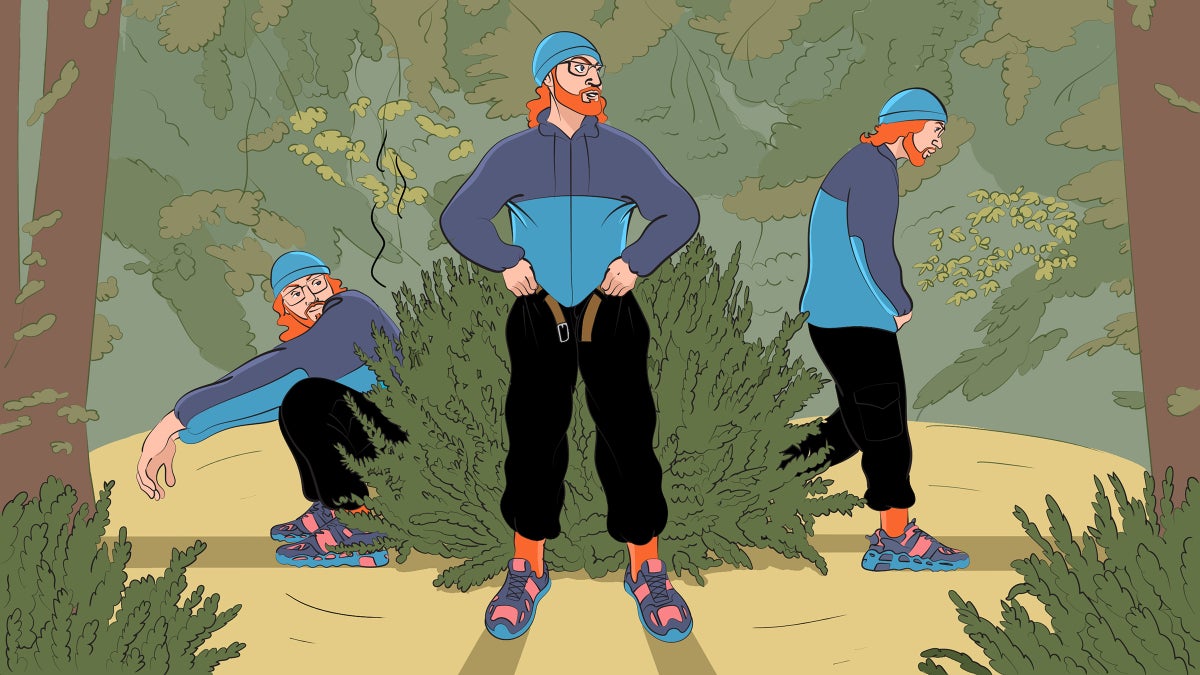No products in the cart.
Outdoor Adventure
Has Pooping Outdoors Been Ruined Forever?
Get full access to Outside Learn, our online education hub featuring in-depth fitness, nutrition, and adventure courses and more than 2,000 instructional videos when you
sign up for Outside+.
Dear Sundog: When I was growing up, young and free, pooping outdoors was much more casual and fun because there were fewer people—and fewer rules. Is it possible to follow those rules and still have a glorious bowel movement outdoors, or is the fun ruined forever? —Plugged
Dear Plugged: I suspect that when we mourn the end of being young and free, we’re really grieving the young part. When Sundog reclines at his mighty desk here at Sundog Corporate Headquarters (a single-wide trailer on a dirt road), deep in nostalgia about that time he gripped a juniper branch, hung his arse over the lip of the Grand Canyon, and let one sail, he concedes that perhaps it wasn’t the bowel movement he misses, but the being young and dumb enough to imagine—and execute—this maneuver in the first place.
As a young pup employed to clean the campsites near Utah’s Slickrock Bike Trail, Sundog personally hefted piles of human dung into trash bags and exulted in the eventual installation of pit toilets, even as they offended his au naturel sensibilities. The alternative—the inevitable unearthing of someone else’s pile in your cathedral—is simply worse.
The history of the continent’s most precious places runs parallel to a history of stricter and stricter poop laws—that is, if you concede Sundog’s belief that what makes a place spectacular is a lack of soil. We’re talking here about the cliffed beaches at the bottom of the Grand Canyon, the desert islands of the Gulf of California, the high, dry peaks of the Sierra, and the slot canyons of southern Utah. The conditions—desolation, rock, aridity, stars exploding in the black skies— that attract producers of human waste are the same conditions that make them unable to compost said piles.
The first such test case for managing the inundation was the Grand Canyon, where visitation spiked exponentially in the late 1960s. The pristine beaches of the Colorado River were riddled with fire ash, dirty dishwater, urine stench, and poop cadavers in shallow graves. The secretary of interior himself, Stewart Udall, after a family float through the Grand, demanded that his subordinates “clean up this foul canyon.” Even arch-conservative senator Barry Goldwater pressured the Park Service to make more rules, realizing perhaps that extremism in the defense of rivers is no vice. River runners pushed back against the regulations, with some anonymous naysayer coining the rallying cry: “When you start putting diapers on the cows, we’ll start carrying out our waste!”
Nonetheless, portable toilets—called groovers because of the grooves that appeared on butts after sitting directly on steel boxes—became standard not just in the Grand Canyon but on all western rivers, so much so that by the time Sundog started guiding in the early nineties, these stink boxes were no more controversial than stoves or tents or propane tanks, and the occasional putrid whiffs generated by hauling them downriver became just part of the larger joy of running rivers. Who among us hasn’t taken pride in situating the groover on a secluded embankment overlooking the swirling current, only to revel in the landscape during the morning visit?
Hauling poop on a boat in a steel box is one thing; carrying turds in your own backpack is quite another. Yet in the past two decades, landlocked spots overrun by explorers have followed the rivers’ lead. For a short while, outdoor educators proposed the “smear,” an ecologically sensible method of spreading shit on exposed rock slabs, allowing sun and wind to desiccate and disseminate. But stumbling across these Jackson Pollack–like masterworks proved socially unacceptable. (To be clear, the best solution in wet climates with rich soil is still the trusty dig-and-bury.)
The next solution: a wag bag, a plastic sack that accepts direct deposits and, according to experts, “contains chemical crystals that gel human waste and render it inert.” Such devices are now required above tree line on Mount Shasta and Mount Whitney in California, as well as on popular overnight hikes in southern Utah’s Canyonlands and Zion National Parks.
Sundog is no chemist and cannot speak to the promises of feces becoming “inert.” However he can report that after hauling a baggie from a couloir on Mount Shasta, he felt ethical satisfaction that he hadn’t left a land mine to be detonated by some fellow traveler’s crampon or ice ax, and he also ran his pack through a washing machine at a laundromat because, even a week later, the stench seemed embedded in the fabric.
To your question, Plugged, even for a seasoned groover user such as Sundog, there was nothing fun nor glorious about shitting in a bag and then stuffing it in the rucksack beside the salami, cheese, and well-worn copy of Baudelaire’s Les Fleurs du mal, which he habitually carries to the top of summits (“My heart is lost; the beasts have eaten it.” Not to be confused with the perhaps more relevant Shuzo Oshimi graphic novel of the same name, in which a character says: “My hand smells really good these days. Wanna sniff it?”)
However, as with those who resisted groovers and cried for bovine diapers, Sundog fears that those who resist the new changes are on the wrong side of history. That said, the places so crowded and barren that they require wag bags constitute a tiny sliver of public lands available for excremental recreation. Lower your standards—and your britches will follow. You don’t get to do it on top of Mount Whitney or inside the Zion Narrows, but there are still millions of acres where you can sneak to some loamy knoll with southern exposure, dig your six-inch cat hole, and party like it’s 1999.
Source link

